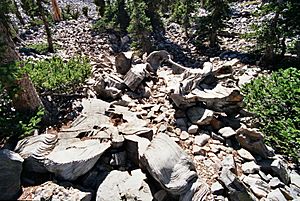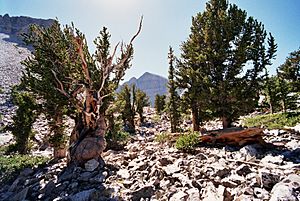Prometheus (tree) facts for kids

Prometheus was an incredibly old Great Basin bristlecone pine tree. It grew high up on Wheeler Peak in eastern Nevada, USA. This tree was at least 4,862 years old, and possibly even more than 5,000 years old!
Prometheus was special because it was the oldest known non-clonal organism. This means it grew from a single seed, unlike some plants that spread by making copies of themselves.
Sadly, the tree was cut down in 1964 by a student and United States Forest Service staff. They were doing research and didn't know how old it was at the time. The decision to cut it down is still a topic of discussion today.
The tree was named after Prometheus, a figure from ancient myths. He was known for stealing fire from the gods and giving it to humans. The tree also had a research code: WPN-114. This code meant it was the 114th tree sampled by researcher Donald Rusk Currey in White Pine County.
Contents
Meet Prometheus: The Ancient Tree
Prometheus (WPN-114) was part of a group of bristlecone pine trees. These trees grew near the tree line on Wheeler Peak. Wheeler Peak is the tallest mountain in the Snake Range in Great Basin National Park, Nevada.
The bristlecone pines on this mountain live in different areas. Some are easy to visit on a walking trail. But Prometheus grew in a spot that required hiking off the main paths.
Around 1958 or 1961, a group of nature lovers visited the area. They gave names to some of the biggest or most unique trees, including Prometheus.
How Old Was Prometheus?
Scientists use a method called dendrochronology to find a tree's age. This involves counting the tree's growth rings. Each ring usually represents one year of growth.
When Prometheus was cut, scientists first estimated it was at least 4,844 years old. Later, another scientist, Donald Graybill, counted 4,862 rings. These rings were counted from a part of the trunk about 2.5 meters (8 feet) above the ground.
Scientists believe the tree was likely over 5,000 years old when it was cut. This is because they added years for the tree to grow to that height. They also added years for any missing rings, which can happen in trees growing in harsh conditions.
At the time, Prometheus was the oldest known non-clonal organism. It was even older than the famous Methuselah tree in California. Methuselah was later found to be 4,850 years old.
Other Really Old Organisms
The idea of the "oldest organism" can be tricky. It depends on what you mean by "oldest" and "organism".
Some plants are "clonal" organisms. This means they grow by sending out new shoots from an older root system. The individual stems might not be very old, but the entire connected plant can be ancient.
For example, a grove of quaking aspens in Utah called Pando is a clonal organism. It might be as old as 80,000 years! But its individual aspen trees are much younger.
Prometheus was special because it was a "non-clonal" organism. It grew from a single seed, and its main trunk was incredibly old.
In 2010, another bristlecone pine in California was reported to be 5,062 years old. However, this tree has not been found since the researcher who measured it passed away in 2013.
Why Was Prometheus Cut Down?
In the 1950s, scientists were actively searching for the oldest living trees. They wanted to study tree rings for many reasons. This included understanding past climates and dating ancient ruins.
Edmund Schulman had already found very old bristlecone pines in California. This made scientists even more interested in finding older ones.
Donald R. Currey was a student studying past climates using tree rings. In 1963, he learned about the bristlecone pines on Wheeler Peak. He thought some of them looked very old. He took core samples from some trees and found some over 3,000 years old. But he couldn't get a complete core sample from WPN-114 (Prometheus).
There are different stories about why the tree was cut. One story says Currey broke his tool for taking core samples. Another says it was too hard to get a good core sample, and a full slice of the tree would give more information. Currey himself said the core samples were too small to read well.
There are also different ideas about how unique Prometheus was. Some people involved thought it was just one of many old trees in the area. Others believed it was clearly much older than the rest.
In 1965, Currey wrote that he had the tree cut for two main reasons. First, he wanted to see if the oldest bristlecones were only found in California. Second, he wanted to study the climate of the Little Ice Age. This was a period of colder temperatures that happened long ago.
The tree was cut down in August 1964. Parts of it were taken away for study. Today, pieces of Prometheus can be seen in different places. These include the Great Basin National Park visitor center and the University of Arizona's tree-ring lab.
What Happened After?
The cutting of Prometheus helped lead to better protection for bristlecone pines. It also helped protect the areas where they grow, like Wheeler Peak.
Before this event, there was already an effort to make the mountain a national park. Twenty-two years later, the area officially became Great Basin National Park. Currey even spoke to the US Congress to support the park's creation.
See also
 In Spanish: Prometeo (árbol) para niños
In Spanish: Prometeo (árbol) para niños
- King Clone
- King's Lomatia
- Llangernyw Yew
- Old Tjikko
- List of oldest trees
- List of individual trees



